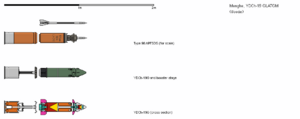YDCh-19: Difference between revisions
No edit summary |
m (1 revision imported) |
(No difference)
| |
Revision as of 17:19, 11 March 2019
| YDCh-19 | |
|---|---|
 YDCh-19A and B variants, with a 125mm HE shell (lower right) for size comparison. | |
| Type | Gun-launched ATGM |
| Place of origin | |
| Service history | |
| In service | 2002-present |
| Used by | |
| Production history | |
| Designer | Hanbyŏl Missile Design Bureau |
| Designed | 1994-2001 |
| Produced | 2001-present |
| Specifications (YDCh-70A) | |
| Weight | 17.4 kilograms |
| Length | 71 centimeters |
| Diameter | 125 mm |
| Wingspan | 29 cm (fins extended) |
| Propellant | solid fuel rocket |
Guidance system | SACLOS beam-riding |
Steering system | aerodynamic surfaces |
The YDCh-19 (Yudotan, Daejŏncha, 19) is a beam-riding anti-tank guided missile developed in Menghe during the late 1990s and fielded in 2002. It is designed to be fired from the 125mm gun of the MinChong-5 tank, as a replacement for the previous YDCh-14 gun-launched ATGM.
Design
In 1991, Menghean tank forces belatedly fielded the YDCh-14 ATGM, a gun-launched projectile which had been in development since the early 1980s. This missile offered some advantages to Menghean tanks, but it was hampered by poor characteristics, leading the Menghean Army to push for a replacement.
The YDCh-19, which entered service in 2002, solved many of those problems. It carried a more effective HEAT warhead, with a precursor charge in the nose to defeat ERA tiles and the outer layers of certain composite armor schemes. It also has a larger solid-fuel rocket motor, extending powered flight range to 5 kilometers. Likewise, the guidance system was improved using components from the YDCh-18 anti-tank missile developed in the Federation of Socialist Republics.
Other changes concerned the missile's structure. Both the YDCh-14 and YDCh-19 were too long to fit in the MinChong-5's carousel autoloader, which separated the projectile and propellant on conventional ammunition. Instead, the missile bodies themselves were broken into two parts, which locked together during the loading process. The YDCh-14 then came with a separate "plug" section with a compressed air booster to propel the missile out of the gun, which a crew member had to manually insert into the breech after both pieces were loaded, further prolonging the loading process to about 15 seconds compared to 5-6 seconds for a regular main gun round. On the YDCh-19, this plug and booster section was included on the missile's rear half in storage, allowing it to be loaded with the same speed as a main gun round. The YDCh-14's rear section also incorporated a spring, reducing the immediate pressure from the compressed air and limiting damage to the sensitive laser receiver in the missile's rear - the source of major reliability problems on the YDCh-14.
YDCh-19B
In addition to using the YDCh-19 against tanks, crews were also trained to use it against loitering or slow-moving helicopters. While the YDCh-19A relied on a direct hit to neutralize the target, or at least a miss to force it to break its own missile lock, the YDCh-19B was a specialized anti-aircraft variant with a laser-based proximity fuse in the nose. The main warhead was also replaced with a continuous-rod warhead, increasing the missile's effective radius against aircraft.
The YDCh-19B was first fielded in 2005, and remains in use today, reportedly accounting for the majority of YDCh-19 missiles in Menghean service.
Service
At the time it was introduced, The YDCh-19 offered modest advantages for Menghean MBTs, allowing them to hit targets at nearly twice the effective range of main-gun rounds. The YDCh-19 was also considerably more accurate than APFSDS rounds aimed by contemporary Menghean fire-control systems, especially in the first round of an engagement before the gunner could adjust aim.
Even at the time it appeared, however, the YDCh-19A's warhead remained too weak to defeat the composite frontal armor schemes on advanced main battle tanks. Its long flight time forced the launching tank to remain stationary for up to fifteen seconds until the round impacted. And as Menghean fire-control systems caught up with the global standard during the 2000s, its accuracy waned by comparison. While compatible with the Suchŏl-6 MBT, it has been out of production since 2014, and is not supported by the electronics on the SuChong-8.